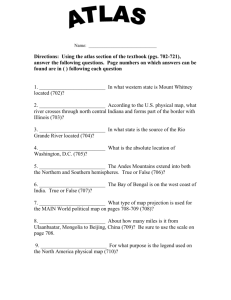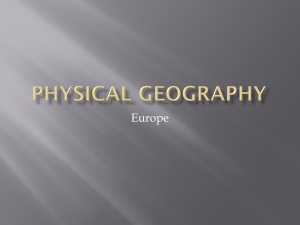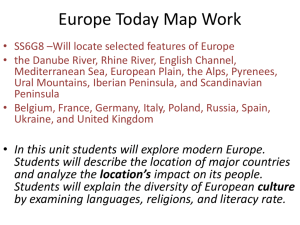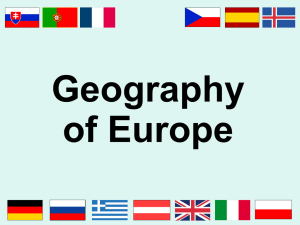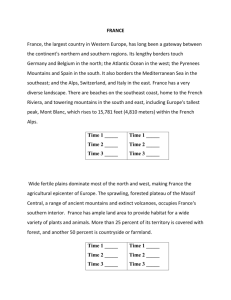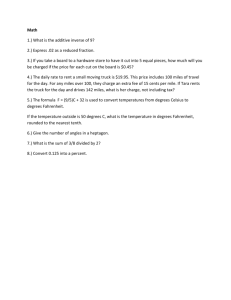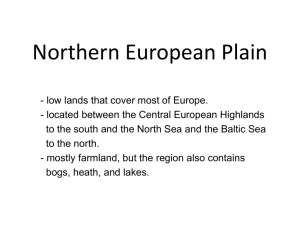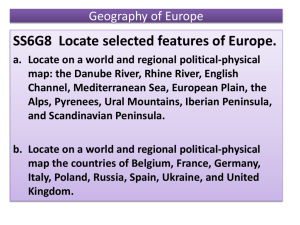File
advertisement
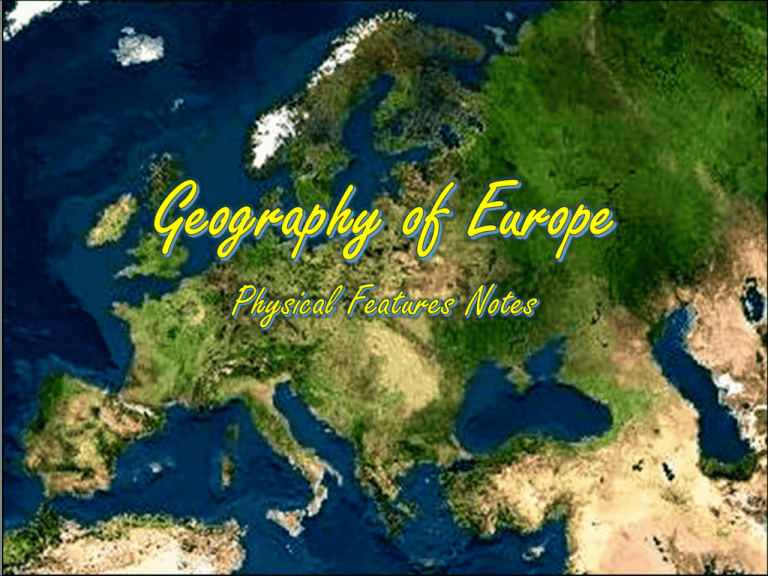
Europe’s Latitude Compared to the U.S. Former Soviet Union Compared in Latitude & Area with the US Satellite View of Europe 3,800 square miles Continents by Size (sq. km.) Asia 44,579,000 Africa 30,065,000 North America 24,256,000 South America 17,819,000 Antarctica 13,209,000 Europe 9,938,000 Oceania (incl. Australia) 7,687,000 Teachers: Print off the following two slides. The students will use an atlas to label the political/physical features of Europe on their maps. Teachers: Print off the following 2 slides. The students will complete the chart while discussing the presentation. (The very important info is in red.) Rhine River • Longest river in Germany • An important waterway for trade • Begins in Switzerland, winds through Germany, France, Luxembourg, & The Netherlands Danube River • 2nd largest river in Europe (Volga is first) • Flows through the 12 countries: Germany, Austria, Slovakia, Hungary, Serbia, Croatia, Bosnia and Herzegovina, Slovenia, Bulgaria, Romania, and the Ukraine! – --1,770 miles long • Played a vital role in the development of central Europe (trade & cultural diffusion) The Alps • Mountain range located in Austria, France, Germany, Switzerland, above Italy, Slovenia, & Liechtenstein • Major tourist destination • Extend for almost 700 miles! Mt. Blanc in the Alps It’s the highest mountain in the Alps: 15,771 feet. Pyrenees Mountains • Mountain range that forms the natural border between France & Spain • Extend for about 270 miles Ural Mountains • Considered the natural boundary between Europe & Asia • Divide Russia: 1/4 is in Europe, 3/4 is in Asia • 1,500 miles long! • Among the world’s OLDEST mountain ranges • Huge deposits of gold, nickel, silver, platinum, coal, iron, & other minerals Ural Mountains: “The Great Divide” It divides the European and Asian sections of Russia. The English Channel • Small body of water that separates England from France • 350 miles long • In the past, it was used as a good system of defense for England • An important waterway for trade Iberian Peninsula • The Pyrenees form the northern border • 2nd largest peninsula in Europe • Includes the countries of Spain & Portugal Scandinavian Peninsula • Largest peninsula in Europe (1,150 miles long) • Consists of Norway, Sweden, and the northern region of Finland • Region is rich in timber, iron, & copper Scandinavian Peninsula Mediterranean Sea • • • • • Important route for trade & cultural exchange “Crossroads for 3 continents” (Europe, Africa, & Asia) Surrounds Italy Covers an area of 965,000 square miles Name means “in the middle of the earth” (surrounded by land) The European Plain • Largest mountain-free landform in Europe • Stretches from the Pyrenees in the west to the Ural Mountains in the east • Extends 2,000 miles • Successful agricultural area European Plain Teachers: Put the students into groups. Print off the following 8 slides. Give each group 15-30 seconds to write down everything the know about the topic—but they can’t write something that’s already written. When time is up, they must pass the paper to the next group. Teachers: Project a blank map of Europe (next slide) on the whiteboard. Put the students into groups and have one member from each group come to the board. Call out different places/features in Europe and have the students use flyswatters to hit the location. The first person to hit it correctly wins. Teachers: Print off the blank map of Europe for each student. The students will need to work in partners, with only 1 pencil to share. Each group needs a dice. Project the features/countries that you want the students to label on the board. One student begins labeling his map as fast as he can while the other is constantly rolling the dice. As soon as the student rolls a 6, the other student gives him the pencil and he begins labeling. This is a race to see who can complete their maps first, but the catch is they can only label if they roll a 6.



